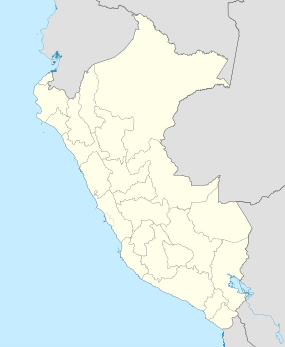Cumbe Mayo
| Kumpi Mayu | |

The aqueduct of Cumbe Mayo includes tunnels
|
|
| Alternate name | Humpi Mayo |
|---|---|
| Location | Cajamarca, Cajamarca Province, Cajamarca Region, Peru |
| Coordinates | 07°11′23″S 78°34′26″W / 7.18972°S 78.57389°WCoordinates: 07°11′23″S 78°34′26″W / 7.18972°S 78.57389°W |
| Type | Aqueduct |
Cumbe Mayo is at an average altitude of 3,500 meters above sea level and 20 kilometers southwest from Cajamarca. Built by an advanced pre-Inca society around 1500 B.C.E, the Cumbe Mayo, which translates to thin river, is thought to be one of the oldest man-made structures in South America. It lies in the Archaeological Complex of Cumbemayo, a place where the highest hydraulic technology of ancient Peruvian communities and the impact of time upon nature are wonderfully combined.
The canals at Cumbe Mayo are thought to be at least 3,000 years old. Archeologists aren’t exactly sure why they were built, but it’s thought that the canals were meant to slow down and regulate the movement of water. They were likely constructed using obsidian hammers.
One of the main attractions of Cumbemayo, or "Narrow River" in Cajamarca Quechua, is the aqueduct. This is a canal of approximately 9 km in length, carefully carved in volcanic rock to divert the water from the hills to cultivation fields and a large reservoir; which is presumably originally at the foot of the Santa Apolonia Hill.
Heading towards the aqueduct one can observe some stairways sculpted in stone, and a carved stone which had been used as a ceremonial altar. Also prominent is the Sanctuary a huge cliff resembling a man's head, whose mouth would be a grotto, where interesting but undecipherable petroglyphs have been found. The caves and shelters of the area evidence other stone engravings, where visitors claim to see anthropomorphic images.
The aqueduct winds down the hills toward the city of Cajamarca, stretching out over about five miles (8 km) in length. The canals brought water from the high grounds to the valleys below, which was especially valuable during times of water scarcity. A number of petroglyphs are also scattered around the aqueduct and in surrounding caves. These symbols provide additional insight into the people who constructed the canals.
Built by an advanced pre-Inca society around 1500 B.C.E, the Cumbe Mayo, which translates to thin river, is thought to be one of the oldest man-made structures in South America. It carefully follows the grade of the land, draining water from the hills’ melting snow, to the arid cities in the valleys below. As water was a scarcity, it was worshipped by the Cajamarca people thousands of years ago, and every drop was carefully collected.
Besides the aqueduct, which is cut from the volcanic rock around it, a number of petroglyphs on the structures and in surrounding caves provide some insight into the culture that built the infrastructure.
Towering above the Cumbe Mayo, are Los Frailones, the Stone Monks. Los Frailones are massive volcanic pillars, some stretching as high as 60 feet(18 m). The stone forests suddenly appear from the landscape, starkly contrasting the flat, grass-covered plains around Cajamarca. The erosive forces of wind and rain likely carved out the pillars.
...
Wikipedia

